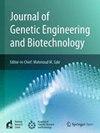Understanding the landscape of cross-species transmission, epidemiology, phylogenetics, and antigenicity of HPAI strain A(H5N1) causing a recent outbreak in the USA
IF 2.8
Q3 Biochemistry, Genetics and Molecular Biology
Journal of Genetic Engineering and Biotechnology
Pub Date : 2025-08-16
DOI:10.1016/j.jgeb.2025.100547
引用次数: 0
Abstract
H5N1 virus infections have repeatedly been reported among wild birds in the USA and throughout the globe. Therefore, the recent outbreak of HPAI strain A(H5N1) in the USA is a global concern that spread among twelve states and three humans in dairy cattle farms. The virus has been reported from cow milk. In this study, we analyzed cross-species transmission, epidemiology, phylogenetics, and virus antigenicity. We depicted different phylogenetic trees using eight genome segments with 1188 genomes (n = 1188) collected from the USA, and the genome clustering at the leaf node level was shown. Here, our analysis found nine different clades. Among these nine clades, 2.3.4.4b clades have spread in the USA. The clade is currently more widespread than the others. Similarly, we have also estimated the transmission in the USA, which shows the cross-species transmission. The study shows the conservation pattern, mutation, and epitopes of two surface proteins, HA and NA. On the other hand, we depicted some significant mutations in different proteins during the outbreak. We found about 11 B-cell epitopes of HA, 15 B-cell epitopes of NA protein, and a possible epitope patch in A-chain of HA. These results suggest that the epitope might be effective for vaccine design against circulating HPAI strain A(H5N1) virus.
了解最近在美国暴发的高致病性禽流感病毒株A(H5N1)的跨物种传播、流行病学、系统发育和抗原性
H5N1病毒感染在美国和世界各地的野生鸟类中反复报道。因此,最近在美国爆发的高致病性禽流感病毒A(H5N1)是一个全球关注的问题,在12个州和3名奶牛农场的人之间传播。据报道,这种病毒来自牛奶。在这项研究中,我们分析了跨物种传播、流行病学、系统发育和病毒抗原性。我们利用从美国收集的1188个基因组(n = 1188)的8个基因组片段绘制了不同的系统发育树,并显示了叶片节点水平上的基因组聚类。在这里,我们的分析发现了九个不同的分支。在这9个分支中,2.3.4.4b分支在美国传播。这个分支目前比其他分支分布更广。同样,我们也估计了美国的传播情况,显示了跨物种传播。研究显示了HA和NA两种表面蛋白的保守模式、突变和表位。另一方面,我们描述了在爆发期间不同蛋白质的一些重要突变。我们发现了11个HA蛋白的b细胞表位,15个NA蛋白的b细胞表位,以及HA蛋白a链上可能的表位斑块。这些结果表明,该抗原表位可能对设计针对HPAI A(H5N1)流行病毒的疫苗有效。
本文章由计算机程序翻译,如有差异,请以英文原文为准。
求助全文
约1分钟内获得全文
求助全文
来源期刊

Journal of Genetic Engineering and Biotechnology
Biochemistry, Genetics and Molecular Biology-Biotechnology
CiteScore
5.70
自引率
5.70%
发文量
159
审稿时长
16 weeks
期刊介绍:
Journal of genetic engineering and biotechnology is devoted to rapid publication of full-length research papers that leads to significant contribution in advancing knowledge in genetic engineering and biotechnology and provide novel perspectives in this research area. JGEB includes all major themes related to genetic engineering and recombinant DNA. The area of interest of JGEB includes but not restricted to: •Plant genetics •Animal genetics •Bacterial enzymes •Agricultural Biotechnology, •Biochemistry, •Biophysics, •Bioinformatics, •Environmental Biotechnology, •Industrial Biotechnology, •Microbial biotechnology, •Medical Biotechnology, •Bioenergy, Biosafety, •Biosecurity, •Bioethics, •GMOS, •Genomic, •Proteomic JGEB accepts
 求助内容:
求助内容: 应助结果提醒方式:
应助结果提醒方式:


